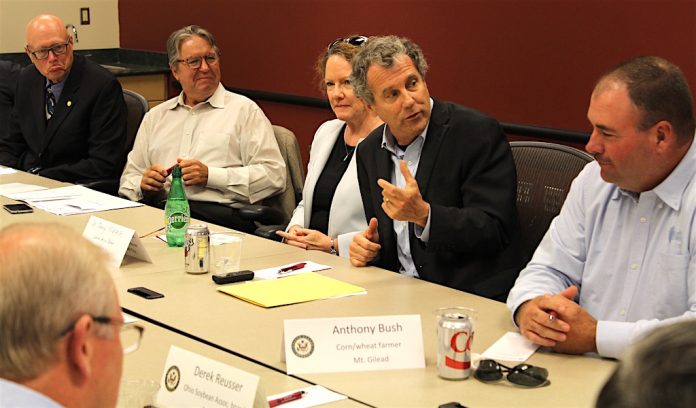WOOSTER, Ohio — Farmers and commodity groups shared their concerns about the last farm bill and the upcoming 2018 farm bill, with U.S. Sen. Sherrod Brown during a roundtable discussion Aug. 28 at the Ohio Agricultural Research and Development Center.
Brown, a Cleveland Democrat, heard from a group of dairy and livestock farmers, crop farmers and Ohio State University experts. Their concerns were broad, but most said the starting point should be making sure the farm bill isn’t cut — especially when it comes to safety nets.
John Linder, a grain farmer from Morrow County, said crop insurance programs have been beneficial to his family’s operation. Federal crop insurance requires 40 percent payment by the farmer, and 60 percent by the government.
“The risk management built into the farm bill has been critical,” Linder said. “We really like the portion where we pay to participate.”
Milk program
Matt Saal, a dairy farmer from Sterling, said dairy farmers are concerned with the current dairy protection program. He said it’s too confusing, it’s not widely used, and is doing little to benefit farmers during low prices.
Saal said farmers can sign up for different levels of margin protection, but he think’s it’s overly complicated, and not popular among the dairy farmers he knows.
Joe Shultz, Democratic staff director for the U.S. Senate Committee on Agriculture, said the last farm bill saved the government $23 billion up front, which led to an actual savings of nearly $100 billion.
The crop insurance program was hailed as one of the biggest accomplishments of the 2014 farm bill, which did away with direct payments and encouraged farmers to invest in their own insurance.
President Donald Trump asked the farm bill writers to do even more cutting when he announced his budget proposal this spring, calling for an additional $29 billion cut to crop insurance, a $123 billion cut to the Supplemental Nutrition Assistance Program and a $6 billion cut to conservation funding.
No more cuts
Those cuts resulted in widespread criticism from farm and conservation organizations, who said they’ve already been cut enough.
“Our message first and foremost is do not cut the farm bill,” Shultz said. “We do not need to be doing cuts. Not in nutrition programs, not in crop insurance, not in conservation, not in commodity programs.”
Shultz said lawmakers have held five hearings on the farm bill and hope to have a new one in place before Sept. 30, 2018, when the 2014 farm bill expires.
He also expects the farm bill will continue to be a bipartisan effort, and that the new bill will continue the tradition of coupling ag programs with food assistance programs.
“I think most people have learned their lesson that we’re going to have a bipartisan bill, and we’re going to have a bill that keeps (food and ag) together.”
Brown said the safety net is important because farmers have so much at risk, including price and yield volatility, along with increasingly severe weather events.
“The safety net is so important,” he said. “It’s important partly because of things beyond your control. … plus it’s in our national interest to have a vibrant farm sector. You don’t want any sector of the economy to get hurt too badly but especially agriculture — what it means down the road to feed our people and to help protect our national security.”











